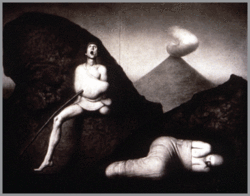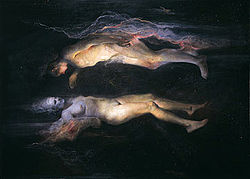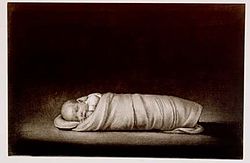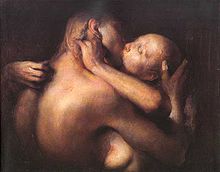- Odd Nerdrum
-
Odd Nerdrum 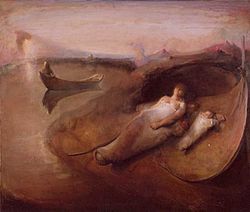
Early Morning, oil on canvas, 206cm x 175.5cm, painting by Odd NerdrumBorn April 8, 1944
Helsingborg, SwedenNationality Norwegian Field Painting Influenced by Rembrandt and Caravaggio Odd Nerdrum (born April 8, 1944 in Helsingborg, Sweden), is a Norwegian figurative painter. Themes and style in Nerdrum's work reference anecdote and narrative, while primary influences by the painters Rembrandt and Caravaggio place his work in direct conflict with the abstraction and conceptual art considered acceptable in much of his native Norway, and in opposition to the art of the time.
Nerdrum creates six to eight paintings per year. These include Still life paintings of small everyday objects like bricks, portraits and self portraits whose subjects are dressed as if from some other time and place, and large paintings, allegorical in nature that present a sense of the apocalyptic and again reference another time.[1]
Nerdrum says that his art should be understood as kitsch rather than art as such. "On Kitsch", a manifesto composed by Nerdrum describes the distinction he makes between kitsch and art.[2]
Contents
Biography
Early life
Odd Nerdrum was born in 1944, in Sweden, during the last year of World War II. His parents, Resistance fighters,[citation needed] had been sent to Sweden from German-occupied Norway to direct guerrilla activities from outside the country. A year later, at the end of the war, Odd and his parents moved back to Norway. Nerdrum's mother, Lillemor soon after that went to New York to study at the Fashion Institute of Technology. The feeling of being unwanted and abandoned Nerdrum felt at this time would stay with him until he was in his late forties, at which time he would begin to understand the underlying reasons for the sensations he felt. In 1950, Nerdrum's parents divorced, leaving Lillemor to raise two small children, Odd, and a younger brother, on her own.[3]
Nerdrum's father, Johan Nerdrum later remarried. Although he was supportive of Odd, he kept an emotional distance between himself and his son. At his death, Odd was asked not to attend the funeral. He found out three years later that Johan was not his biological father. Odd, was in fact, the result of a liaison between David Sandved and Lillemor. Lillemor and Sandved had had a relationship prior to Lillemor's marriage, and this was resumed during the war in a period when Johan was absent. Richard Vine, art critic, describes this episode in Nerdrum's life as one which created "a conflicted preoccupation with origins and personal identity", that "came natural to Nerdrum" and was represented in his pictures.[4]
Early education
Nerdrum began his formal education in 1951 in Oslo, in a private Rudolf Steiner school rather than in the standard, public school system. This education would set Odd apart from his contemporaries. The system was based on anthroposophy that saw mankind as once living in harmony with the universe but now existing in a lesser state of rationality. Through spiritual or esoteric practice, Steiner believed mankind could find its way back to a connection with higher realities and to renewed harmony with the universe. Learning for students was often kinesthetic, for example, through dramatic enactments of history and fantasy, and through musical exercises that were reminiscent of the patterns found on ancient Greek vases, depicting figures moving in parallel patterns. These parallel patterns could be found in later Nerdrum work, as can a sensibility for iconographic images and costume.
Jens Bjørneboe, a grade school mentor said Nerdrum even at that age exhibited tendencies of innate talent and industry, but also impatience with those with less abilities than himself.[4]
Artistic study
Nerdrum began study at the Art Academy of Oslo, but became dissatisfied with the direction of modern art, and began to teach himself how to paint in a Neo Baroque style, with the guidance of Rembrandt's technique and work as a primary influence. Nerdrum had seen Rembrandt's painting, The Conspiracy of Claudius Civilis in the National Museum of Fine Arts in Stockholm. Nerdrum says seeing the painting was "a shock... Pervasive. Like finding home. I can say I found a home in this picture,... The wonderful thing with Rembrandt is the confidence he inspires - like when you warm your hands on a stove. Without Rembrandt I would have been so poor,"[5] By abandoning the accepted path of modern art, Nerdrum had placed himself in direct opposition to most aspects of the school, including his primary painting instructor, his fellow students, and a curriculum designed to present Norway as a country with an up-to-date artistic culture. He, in his own words was chased from the academy after a two-year period like a "scroungy mutt". Years later Nerdrum said,
I saw that I was in the process of making a choice that would end in defeat. By choosing those qualities that were so alien to my own time, I had to give up at the same time the art on which the art of our time rests. I had to paint in defiance of my own era without the protection of the era's superstructure. Briefly put I would paint myself into isolation.[6]
Nerdrum later studied with Joseph Beuys, at the Kunstakademie Düsseldorf.
Direction
Early work 1964-1982
Nerdrum's work from the first twenty years of his artistic life consisted of large canvasses, generally polemic in nature, that served to refute accepted social or economic view points. The work from this period was highly representational and detailed in nature with often careful attention to contemporary references, such as in clothing, or in the model of a bicycle as in the painting The Arrest. Vine notes that, Nerdrum's influence was not, as might be expected, given the themes of the work, of the ideological Ashcan school movement, but predates the Ashcan school, although similar in subject matter. In 1968, Nerdrum had viewed for the first time the works of Caravaggio whose psychologically intense work, use of cross lighting, strongly suggested shadow that implied three dimensionality, and use of the faces of real, everyday people impacted him intensely, and provided one of the major influences for his work of this time period. He would revisit Italy and Caravaggio's work for on-going inspiration for many years.
As well, Nerdrum was a reader of visionary literature that included works by Rudolf Steiner, the prophetic William Blake, the dark Dostoyevsky, and the mystical Swedenborg. This would influence him towards a more vertical sensibility rather than the linear Marxist view based on revolution that influenced most artists with socially reformist sensibilities.
As a young student, Nerdrum had encountered the works of the master painters in the National Museum. In particular, Rembrandt's The Conspiracy of Claudius Civilis (1661) acted as a powerful antidote to his sensibilities. His disillusionment with modern art, such as Rauschenberg's Monogram,[7] a stuffed goat with a tire around its middle section standing on a flat, littered surface, that Nerdrum had encountered in Moderna Museet, filled the young artist with disgust.
These influences both positive and negative would impact all of Nerdrum's work. A turning point in Nerdrum's work - the end of Nerdrum's more contemporary scene-like work, and the movement towards more Rembrandt-like painting elements- revolved around the enormous (11x16¾ foot) Refugees At Sea (1979–1980). Nerdrum, according to Vine, later considered the work to be naive in the sense that Rousseau defines the word, in which mankind is seen as innocent and innately good. In the painting Nerdrum endows the refugees, 27 Vietnamese boat people, with heroic stature, but in a highly sentimentalized manner that Nerdrum later described as "cloying".
Change in direction
In 1981 Nerdrum created a seminal work that would serve to indicate a change in direction from the sentimentalized view of Refugees at Sea to a starker, unadorned view of reality. Twilight a rear view of a young woman alone in a wooded landscape defecating, offers nothing sentimental or ideal in its betrayal, but instead offers a stripped away view of life and reality.
Paintings were no longer as multi-figured as they had been with Refugees at Sea, and still lifes were of individual objects such as a brick or loaf of bread. The individuals who now populated Nerdrum's painting were imbibed with great quiet and stillness, but as Vine says, additionally, were vitally alive evoking a cosmic oneness, but yet did not transcend individuality.
These figures, as types rather than endowed with features or apparent stories that might distinguish them as individual, were costumed in garments that seemed timeless: furs, skins, leather caps, rather than in clothing that would link the viewer to a specific time and place.
Archetypal-like, these beings, inhabited pre-social, apocalyptic-like circumstances that included stark, severe landscapes, a reference to some place beyond our own time and space.
Painting technique
Nerdrum's approach to painting is based on traditional methods that included mixing and grinding his own pigments, working on canvas he had stretched or stretched by assistants rather than on pre-stretched canvas, and working from live models often himself, and in many cases members of his own family. In a 2011 court case, Nerdrum claimed that the technique he used in the 1980s was faulty, "a special mixture of oils and paint in an effort to recreate the style of the old masters" which subsequently melted and disintegrated.[8]
On kitsch
Odd Nerdrum has declared himself to be a kitsch-painter identifying himself with kitsch rather than with the contemporary art world. Initially, Nerdrum's declaration was thought to be a joke but later, and with the publication of articles and books on the subject, Nerdrum's position can be seen as an implied criticism of contemporary art.[9]
Process
Of his process Nerdrum says." When I paint as if I struggle in the water. I will try with all means not to drown. Sandpaper, rags, my fingers, the knife-in short everything. The brush is rarely used."[6]
Influences
Rembrandt and Caravaggio were primary influences on Nerdrum's work, while secondary influences include Masaccio, Leonardo da Vinci, Michelangelo, Titian, and the less obvious influences, according to Vine and either mentioned by Nerdrum himself or other critics, that include Brueghel[disambiguation needed
 ], Goya, Chardin, Millet, as well the even less apparent Henry Fuseli, Caspar David Friedrich, Ferdinand Hodler, Edvard Munch, Käthe Kollwitz, Salvador Dalí, Chaim Soutine and Lars Hertervig.
], Goya, Chardin, Millet, as well the even less apparent Henry Fuseli, Caspar David Friedrich, Ferdinand Hodler, Edvard Munch, Käthe Kollwitz, Salvador Dalí, Chaim Soutine and Lars Hertervig.Drawings and prints
Odd Nerdrum prints are based on his paintings. An etching entitled Baby is based on a painting of the same title from 1982. Nerdrum refers to his highly finished, charcoal drawings as "paintings" Often his drawings are large in scale and are works in their own right, as well as being studies for future paintings.
Collections
Odd Nerdrum's work is held in several public collections worldwide including in the United States: the Hirshhorn Museum and Sculpture Garden in Washington, D.C., the Metropolitan Museum of Art, New York City, New York, New Orleans Museum of Art (NOMA), New Orleans, Louisianna, Museum of Contemporary Art San Diego (MCASD), San Diego, California, Walker Art Center, Minneapolis, Minnesota, Cleveland Center for Contemporary Art, Cleveland, Ohio, and in Norway, the National Gallery in Oslo. Odd Nerdrum is represented by the Forum Gallery, New York City.
Exhibitions
Kunstnerforbundet 1967-70-73 Oslo-76-84Galleri 27 Oslo, 1972
The Bedford Way Gallery, 1982
Martina Hamilton Gallery, 1984
Delaware Art Museum, Wilmington, 1985
The Museum of Contemporary Art, Chicago IL, 1988
Lemberg Gallery Birmingham,MI, 1991
Gothenburg Art Museum, Sweden, 1991
Bergen Art Museum, Norway, 1992
Edward Thorp Gallery, New-York, 1992
New Orleans Museum of Art, 1994
Forum Gallery, New-York, 1996
Frye Art Museum, Seattle, 1997
Astrup Fearnley Museum of Modern Art, Oslo, Norway, 1998
Kunsthal Rotterdam, The Netherlands 1999
Amos Anderson Art Museum, Helsinki, Finland, 1999
Young Classic, 2000
Harry Bergman Gallery, Stockholm, Sweden, 2000
Åland Art Museum, Mariehamn, Finland, 2000
Forum Gallery, New York and Los Angeles, 2002, 2004
Forum Gallery, Los Angeles, 2006
Forum Gallery, New York, January, 2007
Forum Gallery, New York, May, 2007
Reviews
"There are more men than women here, but sexual pairing seems to occur only in death (or a sleep resembling death). Which is not to say desire is nowhere present. It is everywhere. If anything makes these pictures compelling, it's their consistent fascination with the human body. The images—of paired corpses, madmen, men in pain, a man without eyes—may be frightful and abhorrent, but every limb and torso is lovingly rendered. Pale, muscular, sexual, the figures are painted so that one must take them seriously—in much the same way that it is music that grounds the otherwise bizarre stage spectacles of Wagnerian opera."
Nerdrum's work as inspiration
A well-known 2000 horror film, The Cell, contains a scene that was heavily influenced by Nerdrum's 1990 painting, Dawn. The scene features three identical figures sitting down, looking upwards with pained, trance-like expressions on their faces. Director Tarsem Singh in the film's audio commentary says that the painting was the inspiration for the scene's imagery. Singh had seen the painting while visiting the owner of the painting, David Bowie.[10]
Nerdrum also created the cover of the progressive rock band, Junipher Greene's LP, Friendship (1971).
Australian choreographer, Meryl Tankard's 2009 dance piece, "The Oracle", was inspired by the work of Nerdrum. The work, featuring the dancer Paul White, exhibited the human form in constant struggle with forces outside of itself.[11]
Legal Difficulties
In 2011, Nerdrum was convicted in Norway of tax evasion and sentenced to two years in prison.[12] His defense claimed that a very large amount of money in a safe deposit box in Austria was "a safety fund for some 36 paintings that he created in the 80’s using an experimental medium which collectors complained began to melt when exposed to heat."[13] The sentence was criticised as excessive.[13] Art professor Øivind Storm Bjerke called the sentence "strict."[14] Under Norwegian law, Nerdrum would be forbidden from any painting activity in prison, as prisoners in Norway are not allowed to pursue business activities while incarcerated.[14]
Bibliography
- Odd Nerdrum and Richard Vine. Odd Nerdrum: paintings, sketches and drawings. Oslo, Norway: Gyldendal Fakta, 2001. ISBN 82-489-0121-1.
- Odd Nerdrum and Jan-Erik Ebbestad Hansen. Odd Nerdrum: paintings. Oslo, Norway: Aschehoug, 1995. ISBN 82-03-26063-2.
- Odd Nerdrum, Jan Åke Pettersson and Astrup Fearnley Museet for Moderne Kunst. Odd Nerdrum: storyteller and self-revealer. Oslo, Norway: Astrup Fearnley museet for moderne kunst: Aschehoug, 1999. ISBN 82-03-22272-2.
- Odd Nerdrum, Richard Vine, E John Bullard and New Orleans Museum of Art. Odd Nerdrum, the drawings. New Orleans, Louisiana: New Orleans Museum of Art, 1994. ISBN 0-89494-047-3.
- Odd Nerdrum, Bjørn Li. Odd Nerdrum: themes: paintings, drawings, prints and sculptures. Oslo, Norway: Press Publishing, 2007. ISBN 82-7547-226-1.
References
- ^ http://www.oddnerdrum.com/frame_odd.htm
- ^ http://www.boiseweekly.com/boise/the-kitsch-campaign/Content?oid=926148
- ^ Vine, Richard (2001). Odd Nerdrum: Paintings, Sketches and Drawings. Oslo: Gyldendal Norsk Forlog A/S, Gyldendal Fokta,.
- ^ a b Vine, Richard (2001). Odd Nerdrum: Paintings, Sketches and Drawings. Oslo: Gyldendal Norsk Forlog A/S, Gyldendal Fokta,. pp. 23–26.
- ^ "Nå snakker Odd Nerdrum igjen" ("Now Odd Nerdrum is talking again") Eivind Kristensen, Dagbladet, May 11, 2010.
- ^ a b Nerdrum, Odd.Themes: Paintings, Drawings, Prints and Sculptures, Press Publishing, Norway, 2007.pg11
- ^ [1]
- ^ Nina Berglund, "Artist pleads ‘not guilty’ to tax evasion," Views and News from Norway, August 3, 2011
- ^ http://www.nerdruminstitute.com/on_biography.php
- ^ "Nerdrum kopiert i Lopez-thriller" ("Nerdrum copied in Lopez thriller"), Jon Selås, Verdens Gang, Sep 8 2000
- ^ http://www.sydneyoperahouse.com/whatson/theoracle.aspx
- ^ Nina Berglund, "Artist Odd Nerdrum sentenced to jail," Views and News from Norway, August 17, 2011
- ^ a b Nina Berglund, "Controversy Follows Conviction of Artist Odd Nerdrum for Alleged Tax Fraud," ArtDaily.com, August 22, 2011
- ^ a b Nina Berglund, "Artist can’t paint in prison," Views and News from Norway, August 19, 2011
External links
- Odd Nerdrum official website
- Forum Gallery - the gallery representing Nerdrum
Categories:- 1944 births
- Living people
- Norwegian painters
- Contemporary painters
- Postmodern artists
- People from Oslo
- Waldorf school alumni
- Norwegian expatriates in Iceland
- Kunstakademie Düsseldorf alumni
Wikimedia Foundation. 2010.

